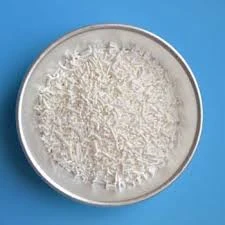
sodium acid pyrophosphate uses in food
The Uses of Sodium Acid Pyrophosphate in Food
Sodium acid pyrophosphate (SAPP) is a compound frequently used in the food industry as a food additive. Known for its multifunctional properties, SAPP serves various roles that enhance the quality, safety, and longevity of food products. In this article, we will explore the uses of sodium acid pyrophosphate in food, discussing its functions, benefits, and regulatory status.
What is Sodium Acid Pyrophosphate?
Sodium acid pyrophosphate is a sodium salt of pyrophosphoric acid. It appears as a white, crystalline powder that is soluble in water. The compound is classified as a leavening agent, acidulant, and stabilizer, which makes it particularly valuable in the production of various food items. Recognized by its E number, E450, it is widely accepted in food processing and is generally regarded as safe (GRAS) by regulatory agencies such as the U.S. Food and Drug Administration (FDA).
Leavening Agent in Bakery Products
One of the primary uses of sodium acid pyrophosphate is as a leavening agent in baked goods. When combined with baking soda (sodium bicarbonate) and moisture, SAPP reacts to produce carbon dioxide gas. This gas creates bubbles in the dough or batter, causing it to rise and resulting in a light, airy texture in products such as cakes, cookies, and quick breads. The effective leavening action of SAPP is particularly beneficial for recipes that require a rapid rise, helping bakers achieve consistent results without the need for yeast fermentation.
Flavor and Color Enhancement
SAPP also plays a role in enhancing flavor and color in processed foods. By acting as an acidulant, it can balance the pH levels of food products, which can improve taste and texture. For instance, in canned vegetables or fruits, SAPP can help maintain color and flavor by balancing acidity, thus enhancing the overall quality of the product. This is essential in retaining the fresh taste of these items during the processing and storage phases.
sodium acid pyrophosphate uses in food

Stabilizer and Thickening Agent
In addition to its leavening and flavor-enhancing properties, sodium acid pyrophosphate acts as a stabilizer and thickening agent in various food applications. It is commonly used in sauces, gravies, and dressings, where it helps to maintain a consistent texture and prevent ingredient separation. SAPP ensures that emulsions remain stable, contributing to the product's shelf life and consumer appeal.
Application in Meat Processing
The food industry also utilizes SAPP in meat processing, specifically in products like prepared meats, sausages, and cured meats. It functions as a pH regulator, which can improve water retention, enhance texture, and prolong shelf life. By reducing the likelihood of spoilage and improving storage stability, SAPP contributes to higher quality meat products that meet consumer expectations for freshness and safety.
Regulatory Status and Safety
Sodium acid pyrophosphate has been evaluated by multiple food safety authorities worldwide. The FDA recognizes it as GRAS, and it is permitted for use in a wide range of food products. However, like all additives, its use is subject to regulatory limits and guidelines to ensure that it is safe for human consumption. Consumers can trust that SAPP, when used according to regulations, poses no significant health risks.
Conclusion
In summary, sodium acid pyrophosphate is a versatile food additive that plays a crucial role in the food industry. Its use as a leavening agent, flavor and color enhancer, stabilizer, and thickening agent has made it an essential ingredient in the production of various food products. As consumers continue to demand high-quality, safe, and flavorful foods, SAPP will remain an important component of many processed items. When used responsibly, this compound not only improves food quality and longevity but also meets the evolving needs of the modern diet.
-
Why Glacial Acetic Acid Food Grade Is Essential in FlavorNewsMay.26,2025
-
Surging Export Growth of Food Additives in ChinaNewsMay.26,2025
-
How Ammonium Nitrate Fertilizer Boosts Crop YieldsNewsMay.26,2025
-
How 1,2,3-Benzotriazole Shields Plastics from UV DegradationNewsMay.26,2025
-
Cyanide in Gold Mining: Protecting People and the PlanetNewsMay.26,2025
-
Aluminum Hydroxide in Modern Sunscreen FormulationsNewsMay.26,2025
-
Understanding Synthetic Rubber OptionsNewsApr.27,2025
Hebei Tenger Chemical Technology Co., Ltd. focuses on the chemical industry and is committed to the export service of chemical raw materials.
-

view more DiethanolisopropanolamineIn the ever-growing field of chemical solutions, diethanolisopropanolamine (DEIPA) stands out as a versatile and important compound. Due to its unique chemical structure and properties, DEIPA is of interest to various industries including construction, personal care, and agriculture. -

view more TriisopropanolamineTriisopropanolamine (TIPA) alkanol amine substance, is a kind of alcohol amine compound with amino and alcohol hydroxyl, and because of its molecules contains both amino and hydroxyl. -

view more Tetramethyl Thiuram DisulfideTetramethyl thiuram disulfide, also known as TMTD, is a white to light-yellow powder with a distinct sulfur-like odor. It is soluble in organic solvents such as benzene, acetone, and ethyl acetate, making it highly versatile for use in different formulations. TMTD is known for its excellent vulcanization acceleration properties, which makes it a key ingredient in the production of rubber products. Additionally, it acts as an effective fungicide and bactericide, making it valuable in agricultural applications. Its high purity and stability ensure consistent performance, making it a preferred choice for manufacturers across various industries.











